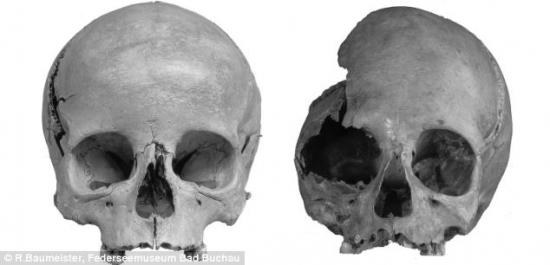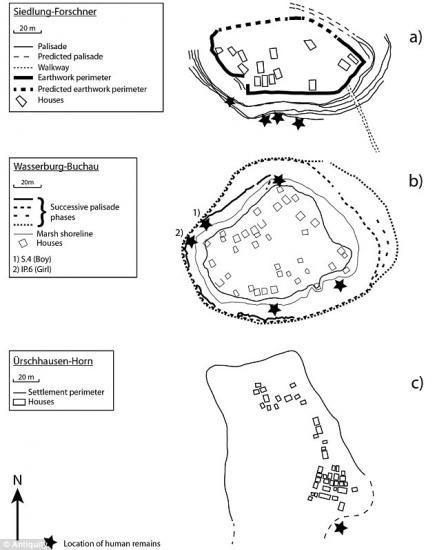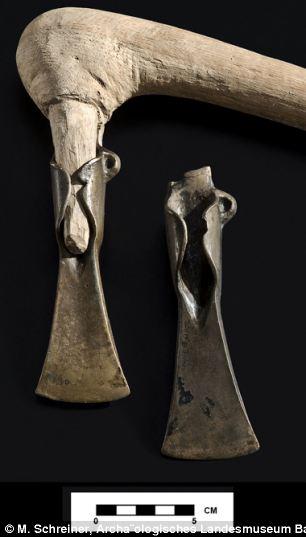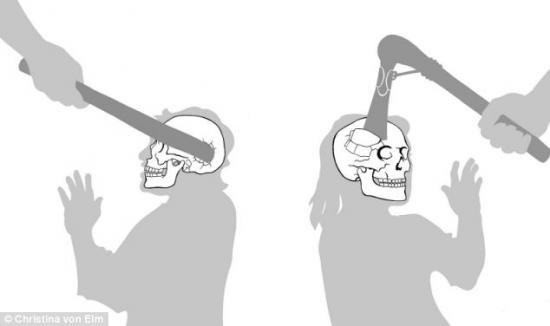Sarah Griffiths
Source - http://www.dailymail.co.uk/sciencetech/article-2688803/Mystery-macabre-rings-baby-skulls-solved-Bronze-Age-circles-offerings-lake-gods-prevent-flooding.html#ixzz37BGA72iB
Skulls were found forming a protective rings around settlements near lakes in Switzerland and Germany
Flooding threatens villages today, yet we are able to build defences such as walls and reservoirs. Bronze Age people living in northern Europe had a more macabre solution, however.
Ancient settlements offered hacked children’s skulls to the local lake gods in order to protect their homes, archaeologists have claimed.
The skulls were found forming a protective ring around settlements near lakes in Switzerland and Germany.

Victims of war: While some of the skulls show signs of head trauma, including slashes inflicted by axes (pictured) it is not thought that the children were human sacrifices
While some of the skulls show signs of head trauma - including slashes inflicted by axes - it is not thought that the children were human sacrifices.
Instead, experts from Basel University, Switzerland believe that bones from long-dead children were offered to lake gods in order to keep rising water levels at bay.
The study, published in the journal Antiquity, says: ‘Several of the children had suffered violent deaths, through blows to the head from axes or blunt instruments.
‘They do not appear to have been human sacrifices, but the skulls may nonetheless have been offerings to the gods by communities faced with the threat of environmental change.’

Mapped: The macabre approach to flood prevention has been found at three sites (marked on this map). Ancient people placed the skulls of children around the perimeters of the villages, especially in places where the water levels rose
Benjamin Jennings, an archaeologist at the university, explained that the Bronze Age lake dwellers faced regular flooding and often moved away from lakes to drier land, only to return later when the water receded.
In order to maximise the time they could spend by the lakes, they built specially adapted houses.
‘The houses were either elevated on stilts (if the village was erected close to or in the water), or on top of a well-insulated wooden surface built directly on the ground (if the settlement was far enough from the lake-shore),’ the study says.
And to supplement such practical defences, they also took more superstitious measures.
Archaeologists uncovered ‘evidence of unusual and macabre human behaviour intended to counter the threat of environmental change’.

Placed with precision: The archeologist said: 'At the sites, the remains are found at the perimeter of the settlement - not inside and not outside, but at a liminal position on the border between in and out'. The drawing shows their location around the village boundaries
The ancient people placed the skulls of children around the village’s perimeter, especially in places where the water levels rose particularly dramatically.
Archaeologists think the bones were intended as ‘gifts to the gods long after primary burial, in order to stop the threatening floods.’

These winged axes from Wasserburg-Buchau are similar in form to the ones that would have been used in Bronze Age battles and inflicted the head wounds on the children
‘A striking similarity that binds all the child skeletal remains together is the location where they were deposited; all of them were found near the settlement perimeter,’ the study says.
‘All the remains were deposited exactly at the time when the severity of flooding became greater.’
By analysing the skulls, the experts found that most of the children were under 10 years old when they died.
While they found evidence of tooth decay and respiratory diseases, they said that they would not have been enough to kill the children.
Instead, the archaeologists believe that they died as a result of blows to the head with axes and clubs, which would probably have been sustained during a war.
They said they the injuries were not similar enough to suggest a type of ritual killing, or human sacrifice.
Dr Jennings told LiveScience: ‘Across Europe as a whole there is quite a body of evidence to indicate that throughout prehistory human remains, and particularly the skull, were highly symbolic and socially charged.’
At the sites, ‘the remains are found at the perimeter of the settlement - not inside and not outside, but at a liminal position on the border between in and out.’
Archaeologists first discovered the ancient alpine villages in 1854 but they were only excavated - yielding bones, dwellings, tools, pottery and jewellery - in the 1970s.
Some wooden artefacts suggest that people lived in such settlements between 3,800 and 2,600 years ago, but little is known about their belief system.
Dr Jennings said: ‘There are very few instance or examples of burials in the vicinity of the lake settlements, and so we really do not know where the majority of the lake dwellers are buried, or how they treated their dead.’

Hacked: Archaeologists believe that the skulls were intended as 'gifts to the gods long after primary burial, in order to stop the threatening floods'. Some of the bones analysed show wounds inflicted by axes and clubs during a war (illustrated)